Super-Resolution of Remote Sensing Images for ×4 Resolution without Reference Images
Abstract
1. Introduction
2. Dataset
3. Methods
3.1. Structure of TS-SRGAN
3.2. Degraded Model
3.2.1. Degradation Kernel Estimation
3.2.2. Generation and Injection of Noise
3.3. SR-GAN
4. Experiments and Results
Training Details
5. Conclusions
Author Contributions
Funding
Data Availability Statement
Acknowledgments
Conflicts of Interest
References
- Verbyla, D.L. Satellite Remote Sensing of Natural Resources; CRC Press: Boca Raton, FL, USA, 1995. [Google Scholar]
- Ye, B.; Tian, S.; Ge, J.; Sun, Y. Assessment of WorldView-3 data for lithological mapping. Remote Sens. 2017, 9, 1132. [Google Scholar] [CrossRef]
- Williams, D.L.; Goward, S.; Arvidson, T. Landsat. Photogramm. Eng. Remote Sens. 2006, 72, 1171–1178. [Google Scholar] [CrossRef]
- Sentinel, E. User Handbook. ESA Standard Document. 2015, Volume 64. Available online: https://earth.esa.int/documents/247904/685211/Sentinel-2_User_Handbook (accessed on 24 July 2015).
- Gargiulo, M.; Mazza, A.; Gaetano, R.; Ruello, G.; Scarpa, G. Fast Super-Resolution of 20 m Sentinel-2 Bands Using Convolutional Neural Networks. Remote Sens. 2019, 11, 2635. [Google Scholar] [CrossRef]
- Lu, J.; He, T.; Song, D.-X.; Wang, C.-Q. Land surface phenology retrieval through spectral and angular harmonization of landsat-8, sentinel-2 and gaofen-1 data. Remote Sens. 2022, 14, 1296. [Google Scholar] [CrossRef]
- Yang, X.; Zhao, S.; Qin, X.; Zhao, N.; Liang, L. Mapping of urban surface water bodies from Sentinel-2 MSI imagery at 10 m resolution via NDWI-based image sharpening. Remote Sens. 2017, 9, 596. [Google Scholar] [CrossRef]
- Gasmi, A.; Gomez, C.; Chehbouni, A.; Dhiba, D.; Elfil, H. Satellite multi-sensor data fusion for soil clay mapping based on the spectral index and spectral bands approaches. Remote Sens. 2022, 14, 1103. [Google Scholar] [CrossRef]
- Li, H.; Shi, D.; Wang, W.; Liao, D.; Gadekallu, T.R.; Yu, K. Secure routing for LEO satellite network survivability. Comput. Netw. 2022, 211, 109011. [Google Scholar] [CrossRef]
- Li, H.; Zhao, L.; Sun, L.; Li, X.; Wang, J.; Han, Y.; Liang, S.; Chen, J. Capability of Phenology-Based Sentinel-2 Composites for Rubber Plantation Mapping in a Large Area with Complex Vegetation Landscapes. Remote Sens. 2022, 14, 5338. [Google Scholar] [CrossRef]
- Wang, J.; Huang, B.; Zhang, H.K.; Ma, P. Sentinel-2A image fusion using a machine learning approach. IEEE Trans. Geosci. Remote Sens. 2019, 57, 9589–9601. [Google Scholar] [CrossRef]
- Rumora, L.; Gašparović, M.; Miler, M.; Medak, D. Quality assessment of fusing Sentinel-2 and WorldView-4 imagery on Sentinel-2 spectral band values: A case study of Zagreb, Croatia. Int. J. Image Data Fusion 2020, 11, 77–96. [Google Scholar] [CrossRef]
- Yang, J.; Wright, J.; Huang, T.S.; Ma, Y. Image super-resolution via sparse representation. IEEE Trans. Image Process. 2010, 19, 2861–2873. [Google Scholar] [CrossRef] [PubMed]
- Gou, S.; Liu, S.; Yang, S.; Jiao, L. Remote sensing image super-resolution reconstruction based on nonlocal pairwise dictionaries and double regularization. IEEE J. Sel. Top. Appl. Earth Obs. Remote Sens. 2014, 7, 4784–4792. [Google Scholar] [CrossRef]
- Pan, Z.; Yu, J.; Huang, H.; Hu, S.; Zhang, A.; Ma, H.; Sun, W. Super-resolution based on compressive sensing and structural self-similarity for remote sensing images. IEEE Trans. Geosci. Remote Sens. 2013, 51, 4864–4876. [Google Scholar] [CrossRef]
- Zhang, Y.; Du, Y.; Ling, F.; Fang, S.; Li, X. Example-based super-resolution land cover mapping using support vector regression. IEEE J. Sel. Top. Appl. Earth Obs. Remote Sens. 2014, 7, 1271–1283. [Google Scholar] [CrossRef]
- Li, J.; Yuan, Q.; Shen, H.; Meng, X.; Zhang, L. Hyperspectral image super-resolution by spectral mixture analysis and spatial–spectral group sparsity. IEEE Geosci. Remote Sens. Lett. 2016, 13, 1250–1254. [Google Scholar] [CrossRef]
- Wang, Z.; Chen, J.; Hoi, S.C.H. Deep learning for image super-resolution: A survey. IEEE Trans. Pattern Anal. Mach. Intell. 2021, 43, 3365–3387. [Google Scholar] [CrossRef] [PubMed]
- Dong, C.; Loy, C.C.; He, K.; Tang, X. Learning a deep convolutional network for image super-resolution. In Proceedings of the Computer Vision-ECCV 2014, Zurich, Switzerland, 6–12 September 2014; Fleet, D., Pajdla, T., Schiele, B., Tuytelaars, T., Eds.; Springer: Cham, Switzerland, 2014; pp. 184–199. [Google Scholar]
- Kim, J.; Lee, J.K.; Lee, K.M. Accurate image super-resolution using very deep convolutional networks. In Proceedings of the IEEE Conference on Computer Vision and Pattern Recognition, Las Vegas, NV, USA, 26 June–1 July 2016; pp. 1646–1654. [Google Scholar]
- Zhang, Y.; Li, K.; Li, K.; Wang, L.; Zhong, B.; Fu, Y. Image super-resolution using very deep residual channel attention networks. In Proceedings of the European Conference on Computer Vision (ECCV), Munich, Germany, 8–14 September 2018; pp. 286–301. [Google Scholar]
- Tai, Y.; Yang, J.; Liu, X. Image super-resolution via deep recursive residual network. In Proceedings of the IEEE Conference on Computer Vision and Pattern Recognition, Honolulu, HI, USA, 21–26 July 2017; pp. 3147–3155. [Google Scholar]
- Hu, J.; Shen, L.; Sun, G. Squeeze-and-excitation networks. In Proceedings of the IEEE Conference on Computer Vision and Pattern Recognition, Salt Lake City, UT, USA, 18–23 June 2018; pp. 7132–7141. [Google Scholar]
- Goodfellow, I.; Pouget-Abadie, J.; Mirza, M.; Xu, B.; Warde-Farley, D.; Ozair, S.; Courville, A.; Bengio, Y. Generative adversarial networks. Commun. ACM 2014, 63, 139–144. [Google Scholar] [CrossRef]
- Ledig, C.; Theis, L.; Huszar, F.; Caballero, J.; Cunningham, A.; Acosta, A.; Aitken, A.; Tejani, A.; Totz, J.; Wang, Z.; et al. Photo-realistic single image super-resolution using a generative adversarial network. In Proceedings of the IEEE Conference on Computer Vision and Pattern Recognition, Honolulu, HI, USA, 21–26 July 2017; pp. 4681–4690. [Google Scholar]
- Wang, X.; Yu, K.; Wu, S.; Gu, J.; Liu, Y.; Dong, C.; Qiao, Y.; Loy, C.C. Esrgan: Enhanced super-resolution generative adversarial networks. In Proceedings of the European Conference on Computer Vision (ECCV) Workshops, Munich, Germany, 8–14 September 2018. [Google Scholar]
- Ma, W.; Pan, Z.; Guo, J.; Lei, B. Super-resolution of remote sensing images based on transferred generative adversarial network. In Proceedings of the IGARSS 2018—2018 IEEE International Geoscience and Remote Sensing Symposium, Valencia, Spain, 22–27 July 2018; pp. 1148–1151. [Google Scholar]
- Haut, J.M.; Paoletti, M.E.; Fernández-Beltran, R.; Plaza, J.; Plaza, A.; Li, J. Remote sensing single-image superresolution based on a deep compendium model. IEEE Geosci. Remote Sens. Lett. 2019, 16, 1432–1436. [Google Scholar] [CrossRef]
- Haut, J.M.; Fernandez-Beltran, R.; Paoletti, M.E.; Plaza, J.; Plaza, A. Remote sensing image superresolution using deep residual channel attention. IEEE Trans. Geosci. Remote Sens. 2019, 57, 9277–9289. [Google Scholar] [CrossRef]
- Lei, S.; Shi, Z.; Zou, Z. Super-resolution for remote sensing images via local–global combined network. IEEE Geosci. Remote Sens. Lett. 2017, 14, 1243–1247. [Google Scholar] [CrossRef]
- Gong, Y.; Liao, P.; Zhang, X.; Zhang, L.; Chen, G.; Zhu, K.; Tan, X.; Lv, Z. Enlighten-GAN for Super Resolution Reconstruction in Mid-Resolution Remote Sensing Images. Remote Sens. 2021, 13, 1104. [Google Scholar] [CrossRef]
- Galar, M.; Sesma, R.; Ayala, C.; Albizua, L.; Aranda, C. Super-Resolution of Sentinel-2 Images Using Convolutional Neural Networks and Real Ground Truth Data. Remote Sens. 2020, 12, 2941. [Google Scholar] [CrossRef]
- Salgueiro Romero, L.; Marcello, J.; Vilaplana, V. Super-Resolution of Sentinel-2 Imagery Using Generative Adversarial Networks. Remote Sens. 2020, 12, 2424. [Google Scholar] [CrossRef]
- Zhang, W.; Liu, Y.; Dong, C.; Qiao, Y. Ranksrgan: Generative adversarial networks with ranker for image super-resolution. In Proceedings of the IEEE/CVF International Conference on Computer Vision, Seoul, Korea, 27 October–2 November 2019; pp. 3096–3105. [Google Scholar]
- Jiang, K.; Wang, Z.; Yi, P.; Wang, G.; Lu, T.; Jiang, J. Edge-enhanced GAN for remote sensing image superresolution. IEEE Trans. Geosci. Remote Sens. 2019, 57, 5799–5812. [Google Scholar] [CrossRef]
- Wang, Z.; Jiang, K.; Yi, P.; Han, Z.; He, Z. Ultra-dense GAN for satellite imagery super-resolution. Neurocomputing 2020, 398, 328–337. [Google Scholar] [CrossRef]
- Zhu, X.; Zhang, L.; Zhang, L.; Liu, X.; Shen, Y.; Zhao, S. GAN-based image super-resolution with a novel quality loss. Math. Probl. Eng. 2020, 2020, 5217429. [Google Scholar] [CrossRef]
- Ji, X.; Cao, Y.; Tai, Y.; Wang, C.; Li, J.; Huang, F. Real-world super-resolution via kernel estimation and noise injection. In Proceedings of the IEEE/CVF Conference on Computer Vision and Pattern Recognition Workshops, Seattle, WA, USA, 13–19 June 2020; pp. 466–467. [Google Scholar]
- Bell-Kligler, S.; Shocher, A.; Irani, M. Blind super-resolution kernel estimation using an internal-gan. Adv. Neural Inf. Process. Syst. 2019, 32, 1–10. [Google Scholar]
- Chen, J.; Chen, J.; Chao, H.; Yang, M. Image blind denoising with generative adversarial network based noise modeling. In Proceedings of the IEEE Conference on Computer Vision and Pattern Recognition, Salt Lake City, UT, USA, 18–23 June 2018; pp. 3155–3164. [Google Scholar]
- Schmitt, M.; Hughes, L.H.; Qiu, C.; Zhu, X.X. SEN12MS-A curated dataset of georeferenced multi-spectral sentinel-1/2 imagery for deep learning and data fusion. arXiv 2019, arXiv:1906.07789. [Google Scholar] [CrossRef]
- Wang, H.-p.; Zhou, L.-l; Zhang, J. Region-based Bicubic image interpolation algorithm. Comput. Eng. 2010, 19, 216–218. [Google Scholar]
- Shocher, A.; Bagon, S.; Isola, P.; Irani, M. Ingan: Capturing and remapping the “dna” of a natural image. In Proceedings of the IEEE/CVF International Conference on Computer Vision, Seoul, Korea, 27 October–2 November 2019. [Google Scholar]
- Isola, P.; Zhu, J.-Y.; Zhou, T.; Efros, A.A. Image-to-image translation with conditional adversarial networks. In Proceedings of the IEEE Conference on Computer Vision and Pattern Recognition, Honolulu, HI, USA, 21–26 July 2017; pp. 1125–1134. [Google Scholar]
- Zhou, R.; Susstrunk, S. Kernel modeling super-resolution on real low-resolution images. In Proceedings of the IEEE/CVF International Conference on Computer Vision, Seoul, Korea, 27 October–2 November 2019; pp. 2433–2443. [Google Scholar]
- Simonyan, K.; Zisserman, A. Very deep convolutional networks for large-scale image recognition. arXiv 2014, arXiv:1409.1556. [Google Scholar]
- Johnson, J.; Alahi, A.; Fei-Fei, L. Perceptual losses for real-time style transfer and super-resolution. In Proceedings of the Computer Vision-ECCV 2014, Zurich, Switzerland, 6–12 September 2014; Leibe, B., Matas, J., Sebe, N., Welling, M., Eds.; Springer: Cham, Switzerland, 2016; pp. 694–711. [Google Scholar]
- Wang, X.; Yu, K.; Chan, K.C.K.; Dong, C.; Loy, C.C. BasicSR. Available online: https://github.com/xinntao/BasicSR (accessed on 19 August 2020).
- Mittal, A.; Soundararajan, R.; Bovik, A.C. Making a “completely blind” image quality analyzer. IEEE Signal Process. Lett. 2012, 20, 209–212. [Google Scholar] [CrossRef]
- Mittal, A.; Moorthy, A.K.; Bovik, A.C. No-reference image quality assessment in the spatial domain. IEEE Trans. Image Process. 2012, 21, 4695–4708. [Google Scholar] [CrossRef] [PubMed]
- Venkatanath, N.; Praneeth, D.; Bh, M.C.; Channappayya, S.S.; Medasani, S.S. Blind image quality evaluation using perception based features. In Proceedings of the 2015 Twenty First National Conference on Communications (NCC), Mumbai, India, 27 February–1 March 2015; pp. 1–6. [Google Scholar]
- Li, Y.; Li, B. Super-Resolution of Sentinel-2 Images at 10m Resolution without Reference Images. Preprints 2021, 2021040556. [Google Scholar] [CrossRef]
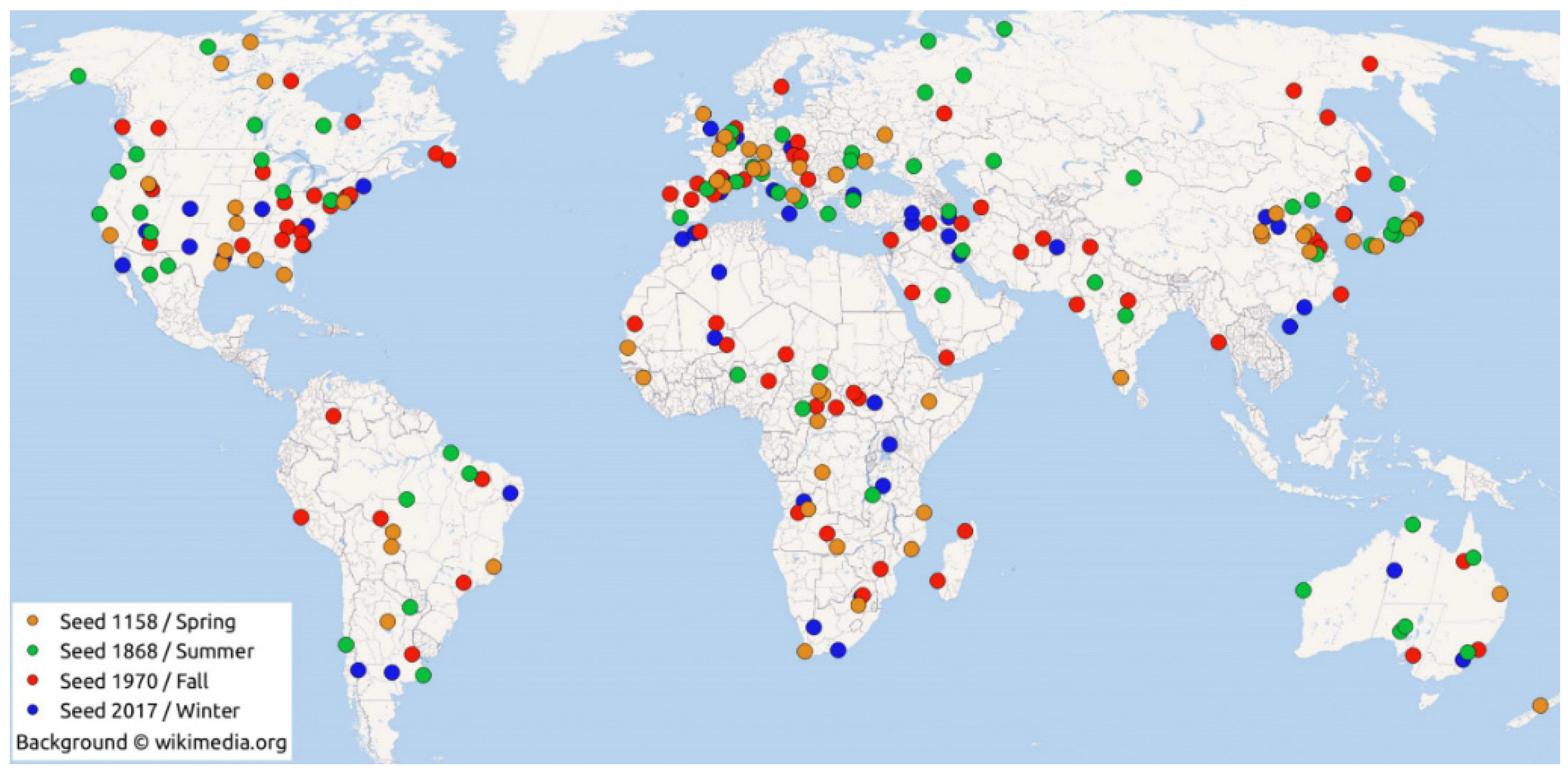
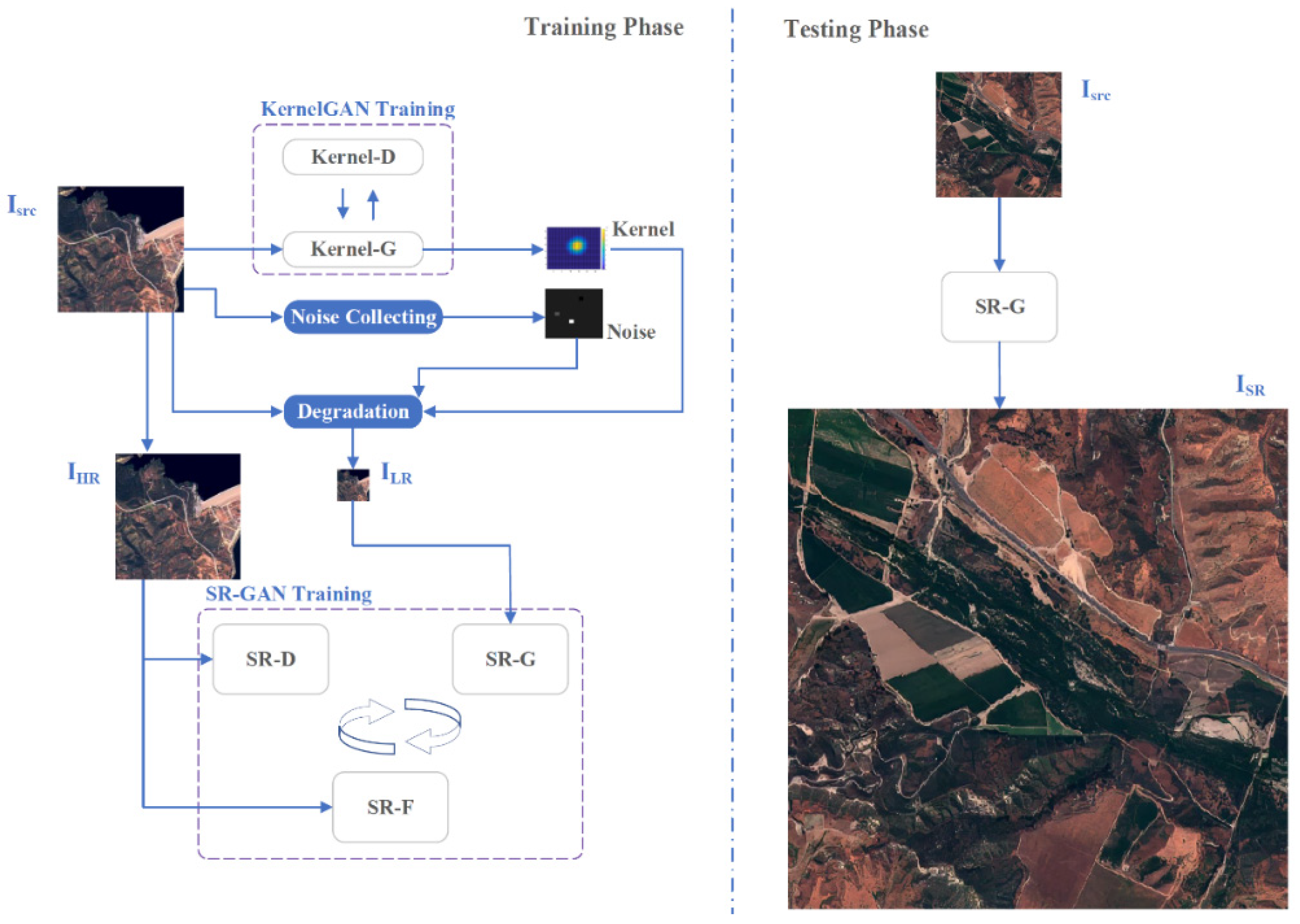


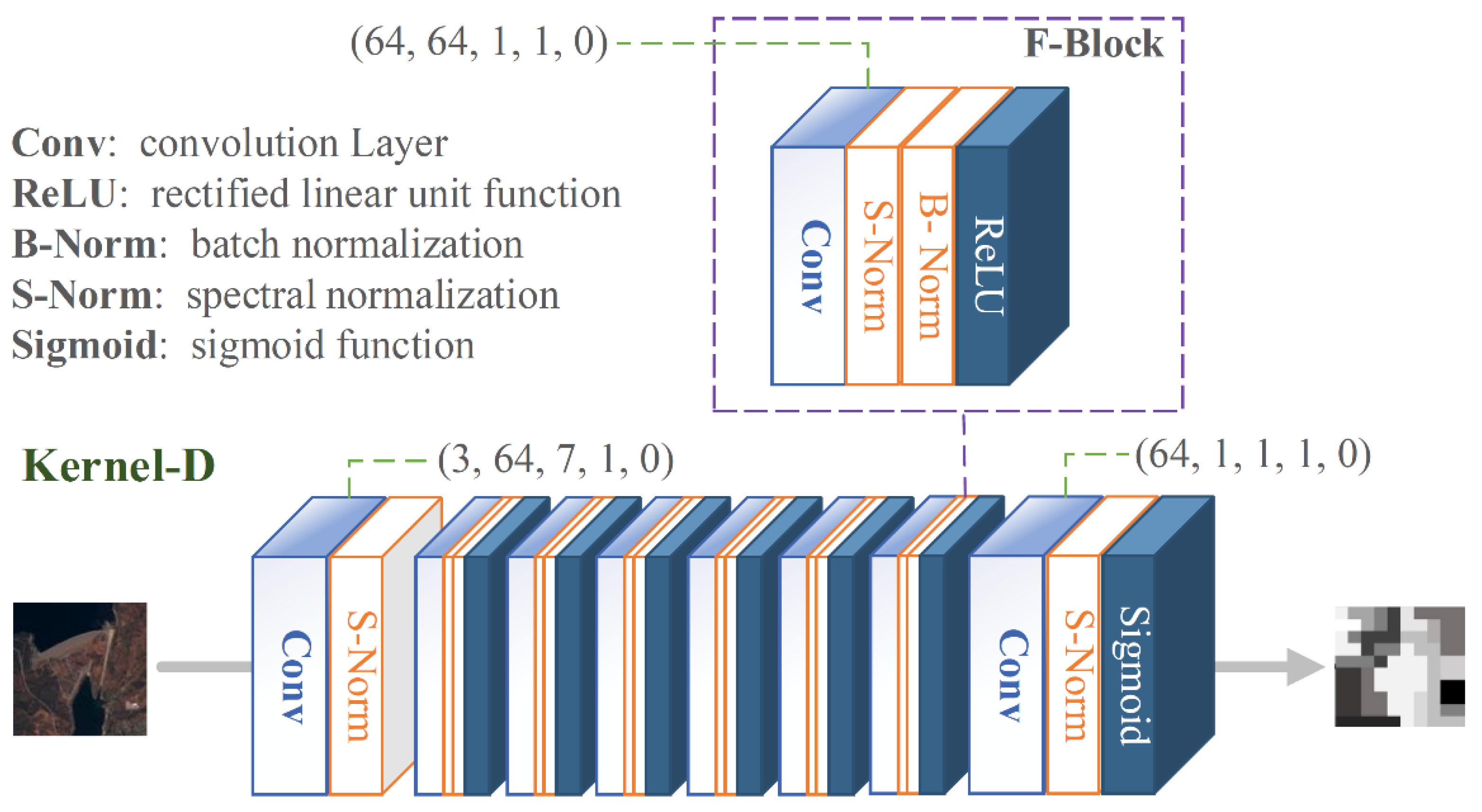
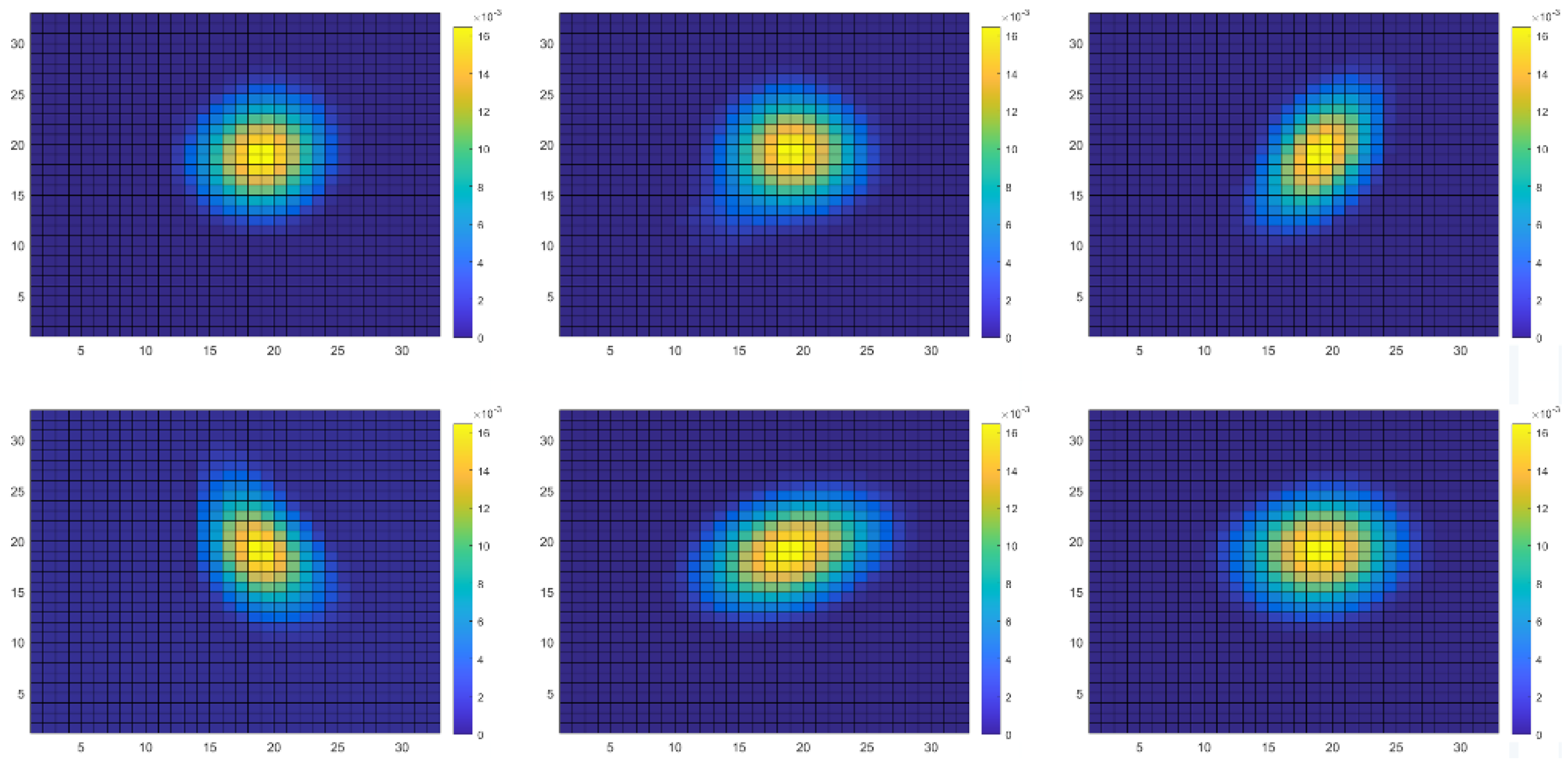
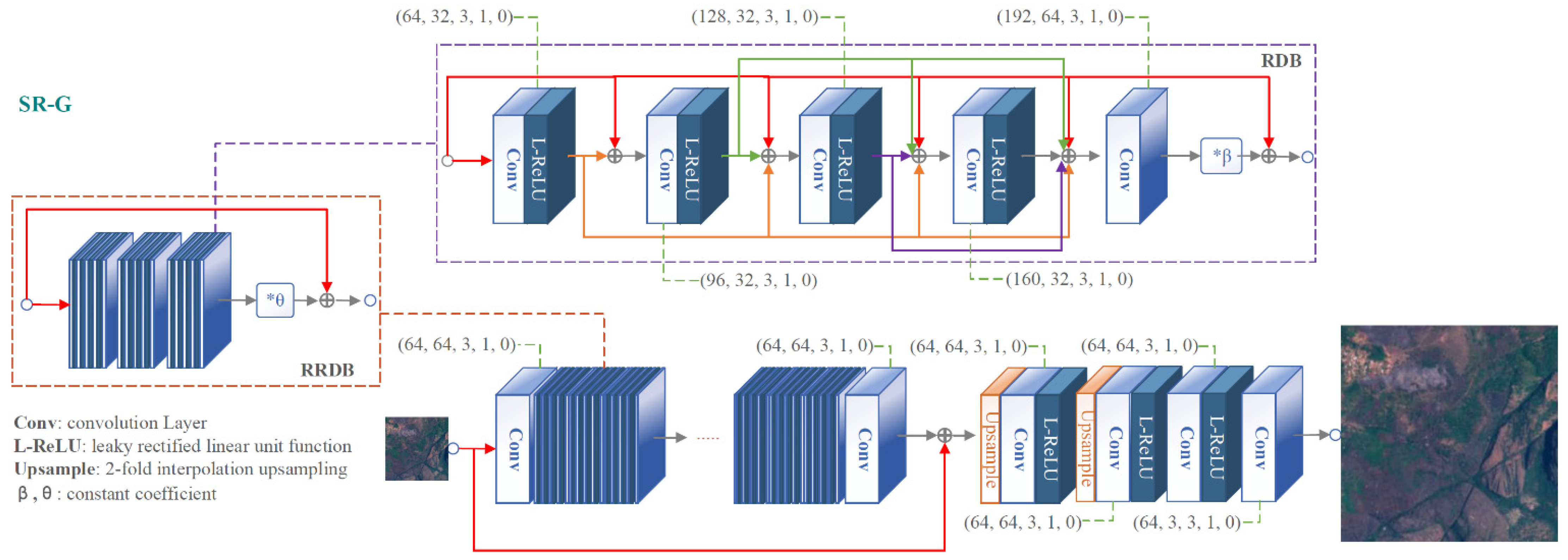
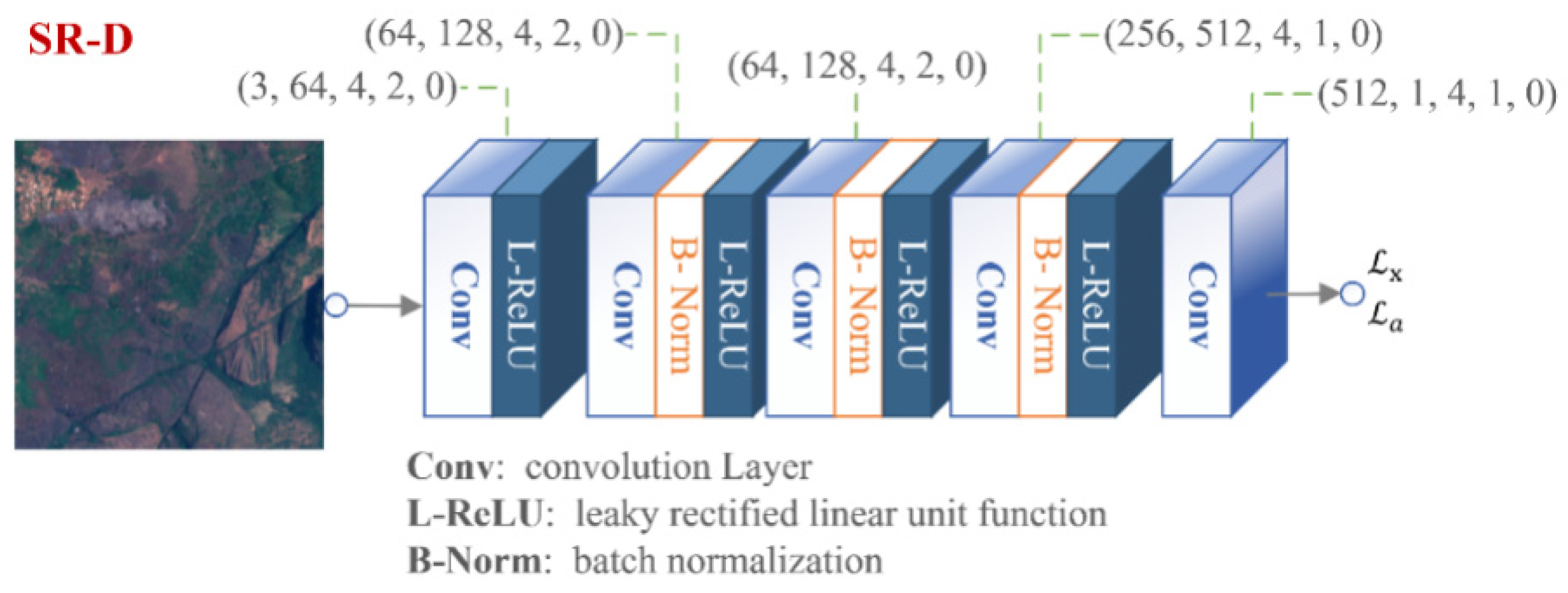



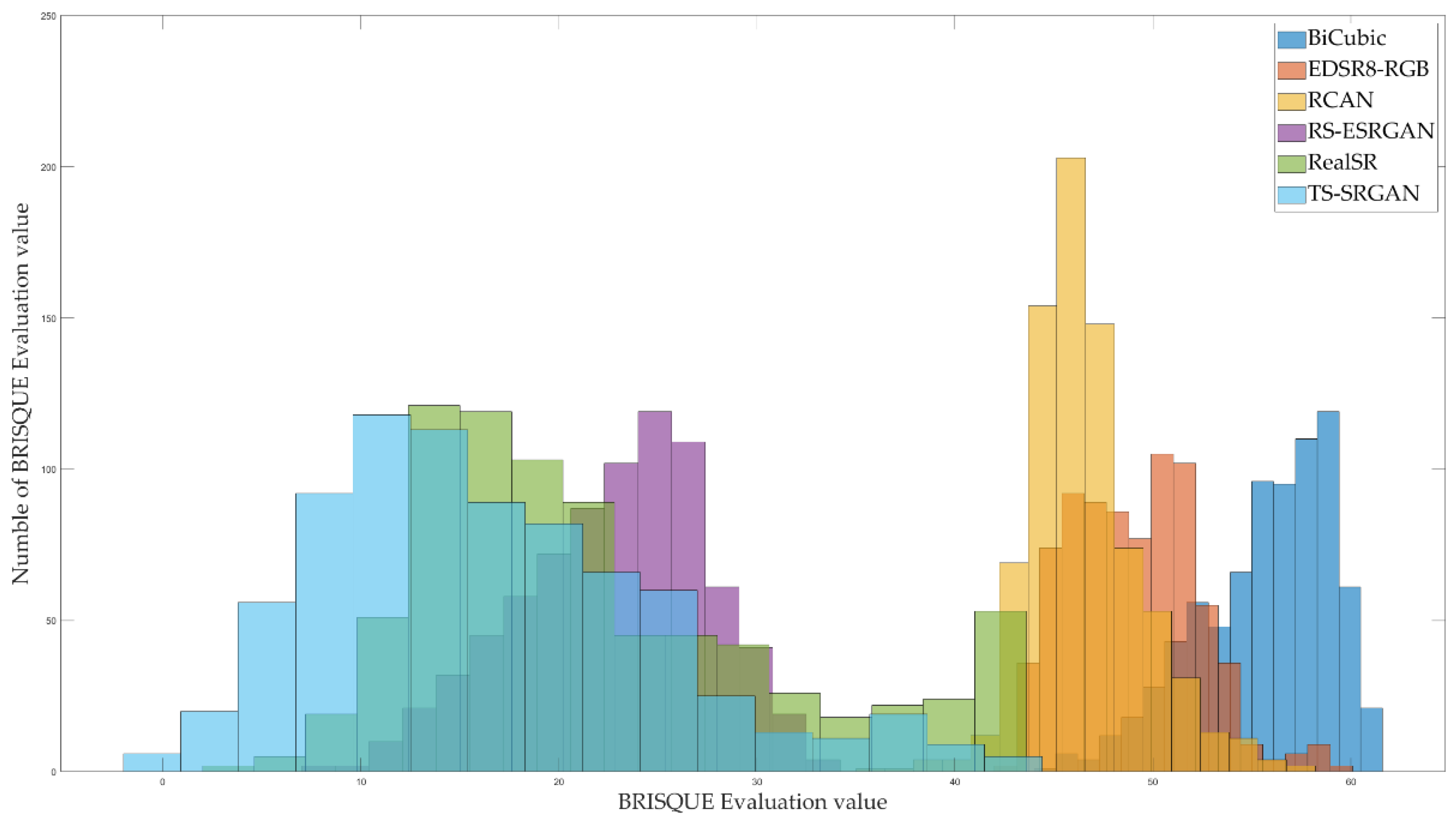

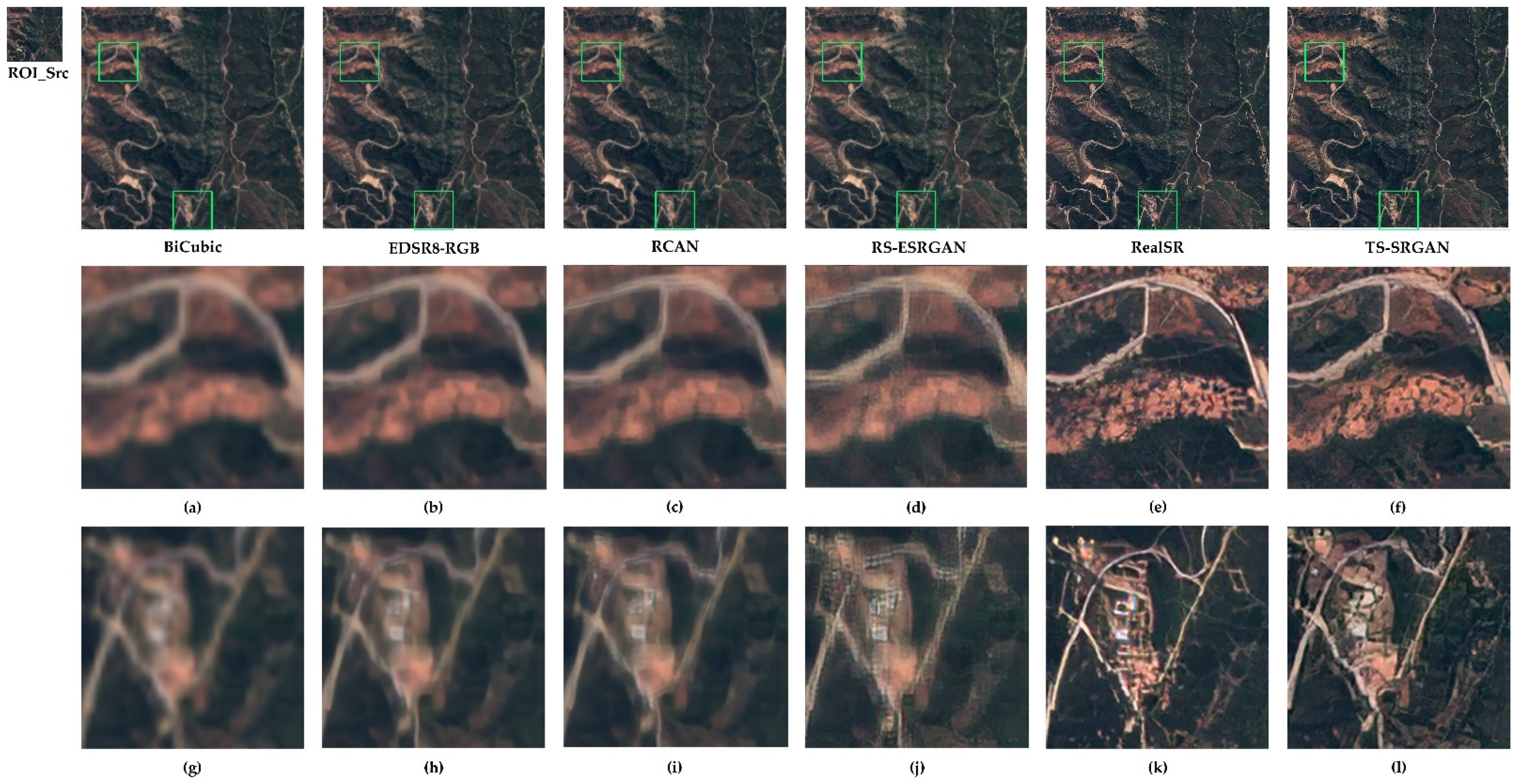

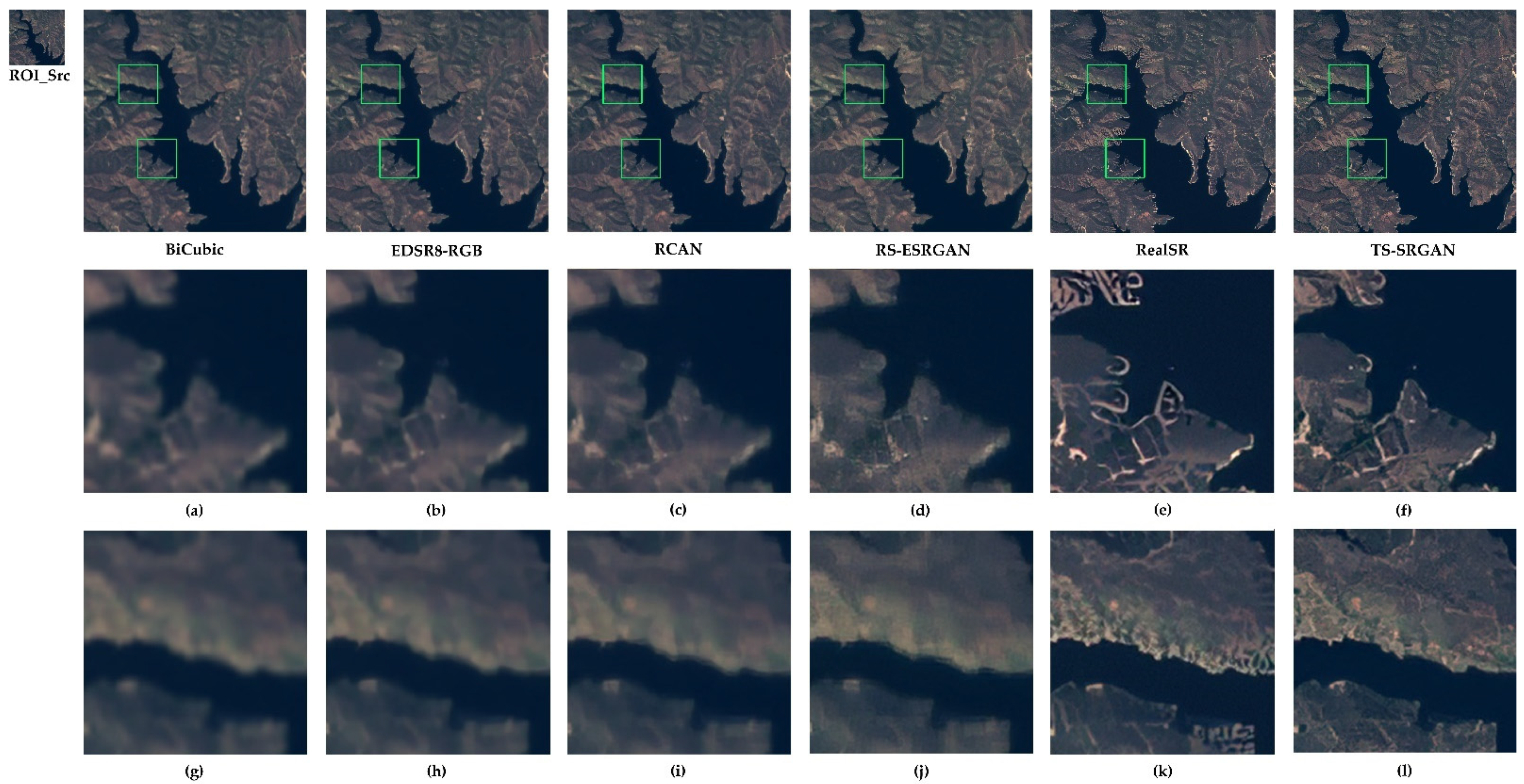
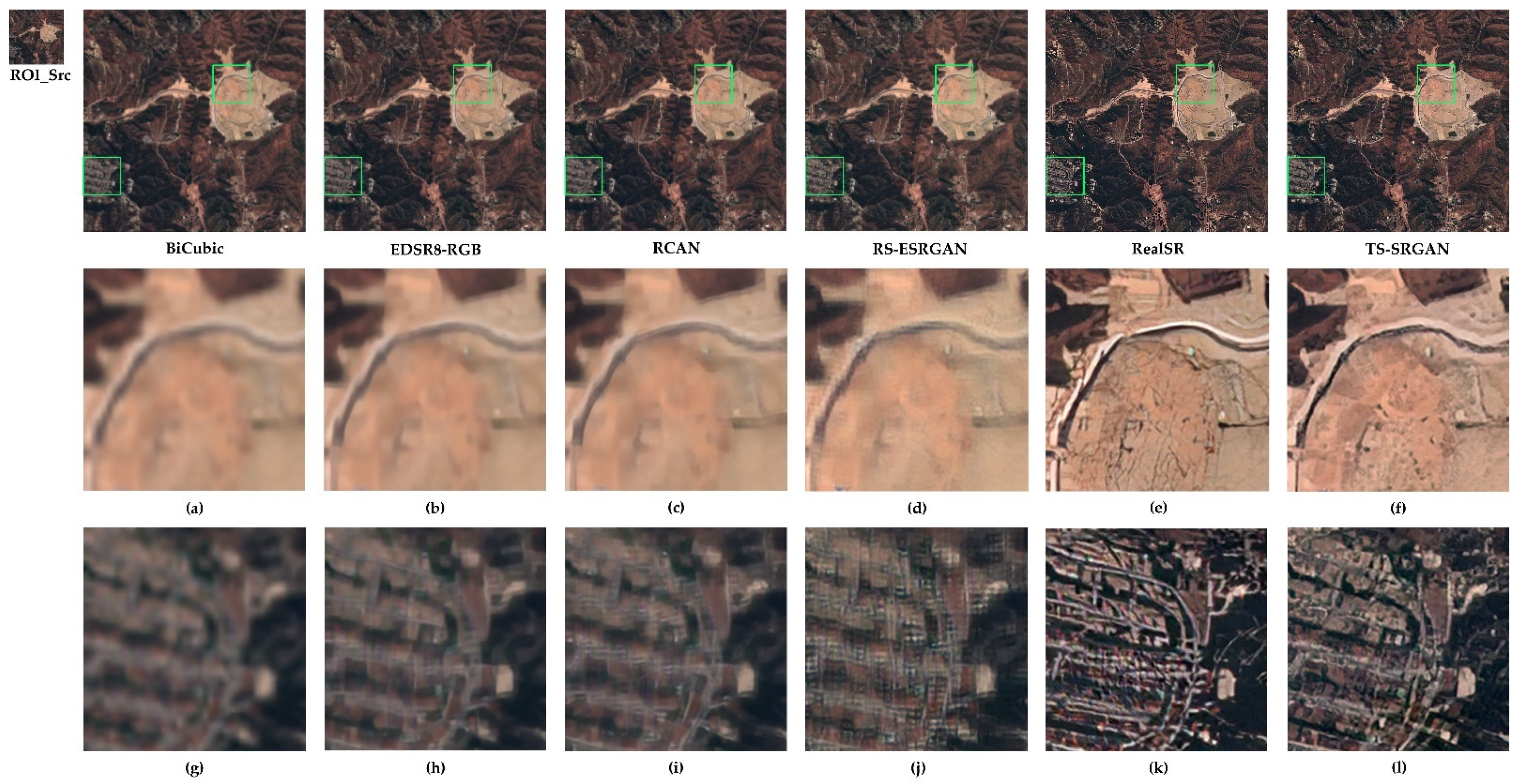
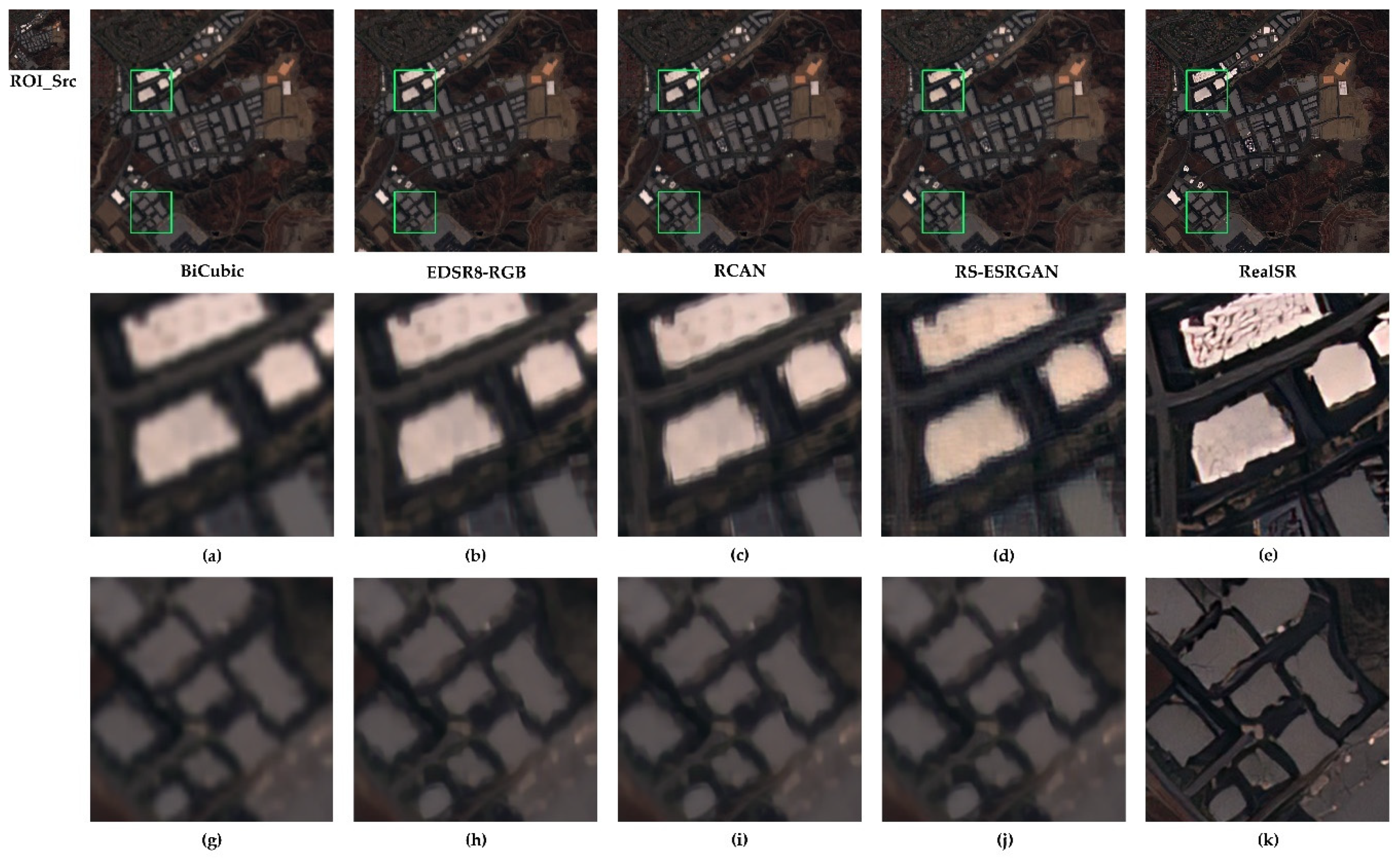
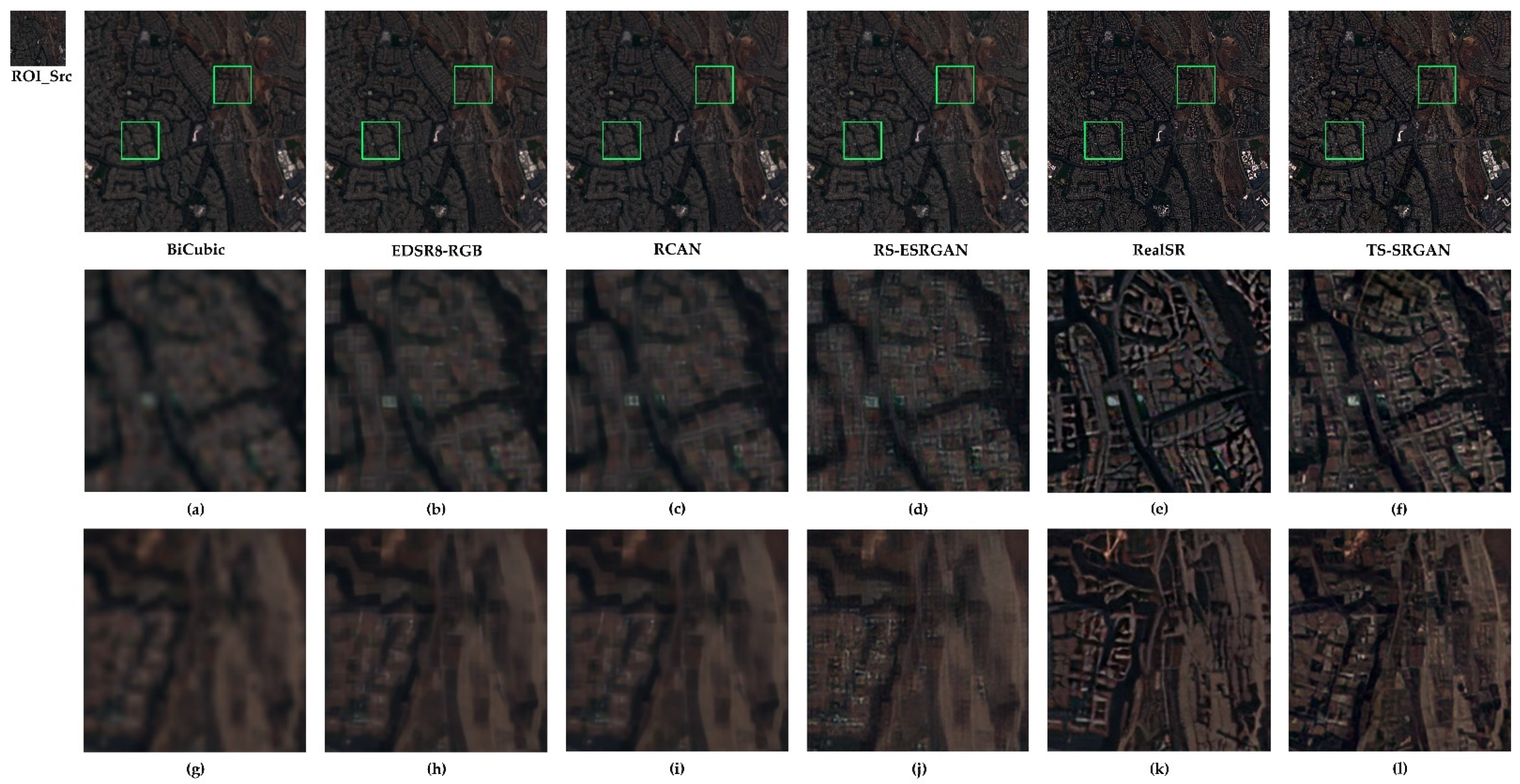
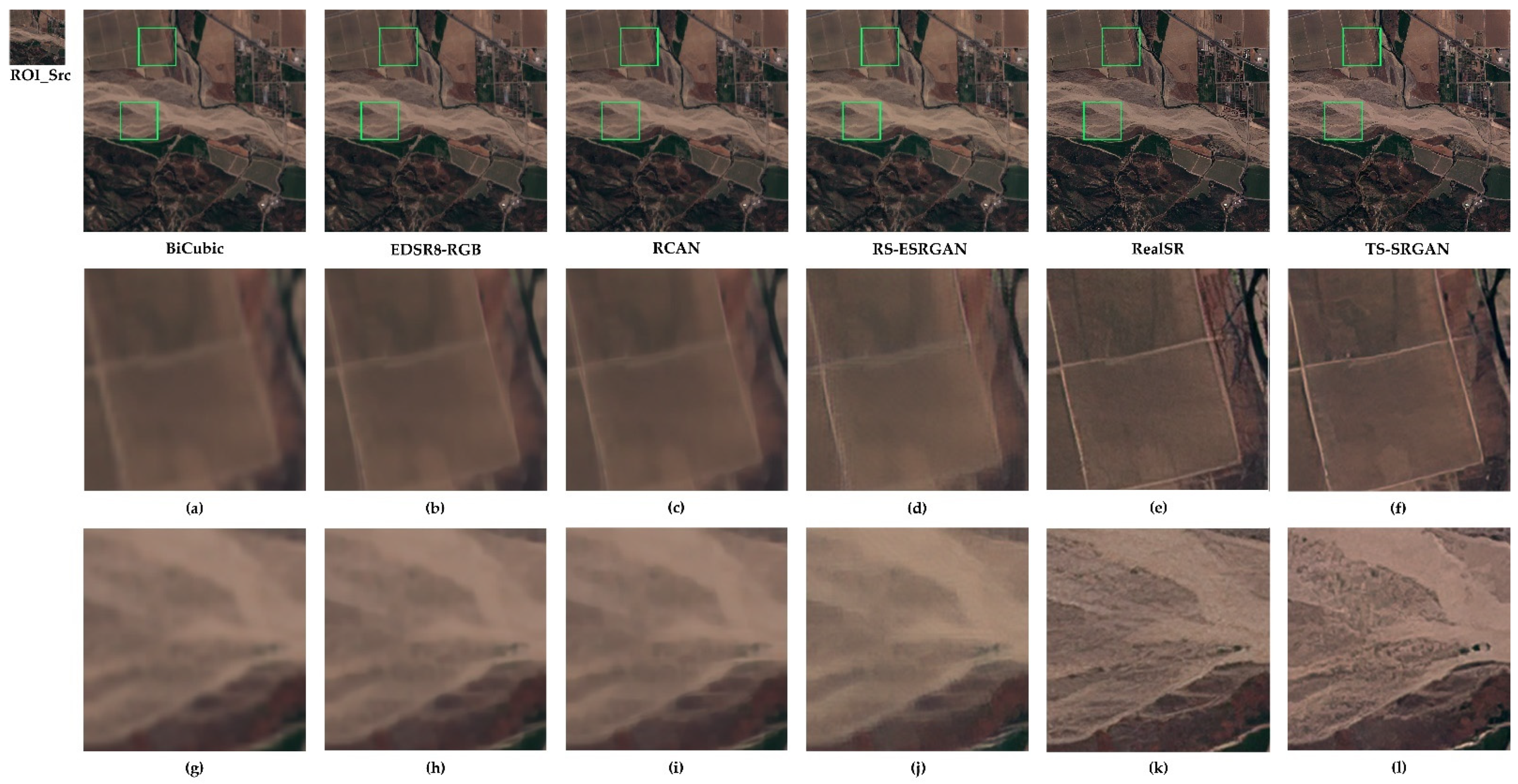
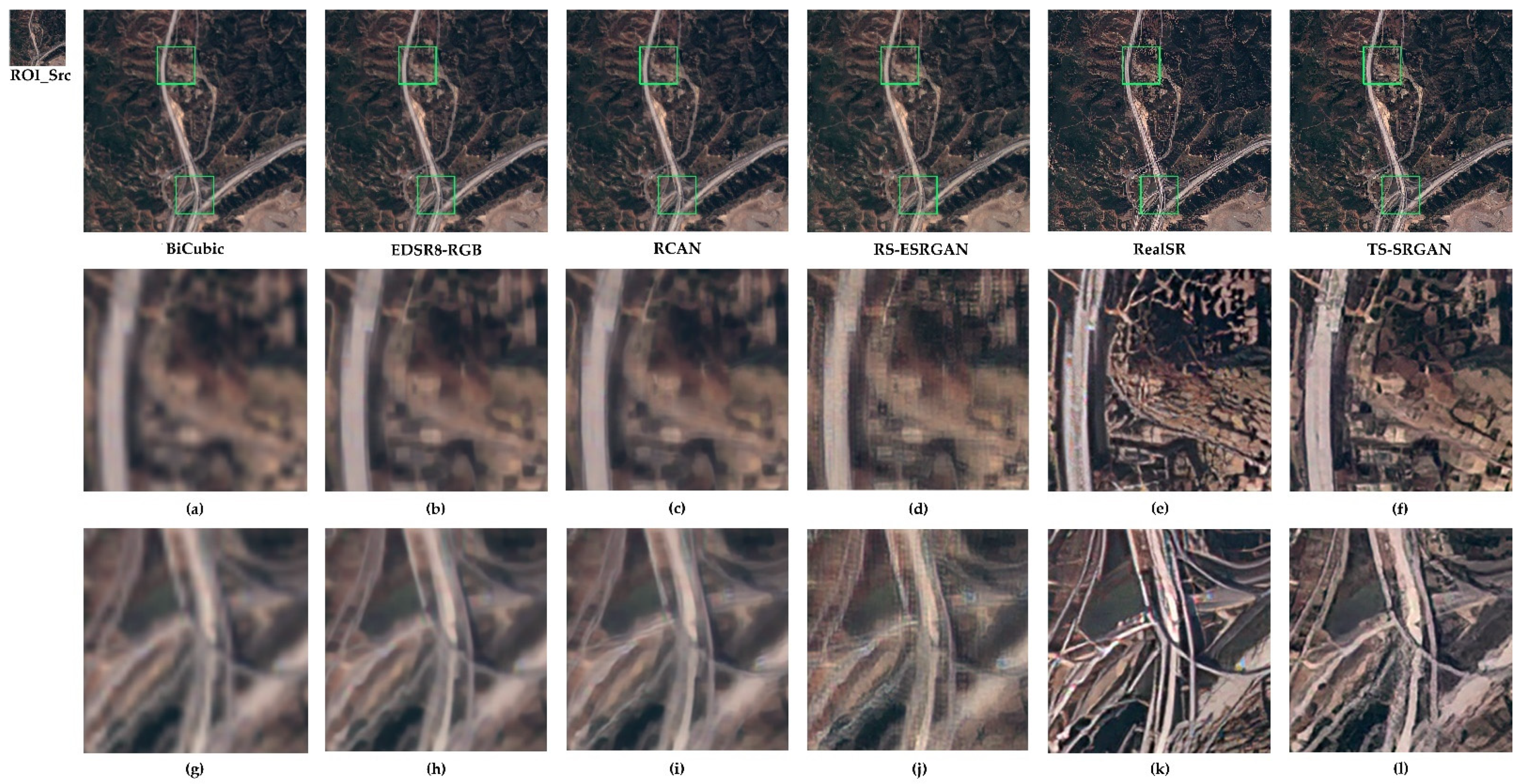
| In_Channels | Out_Channels | Kernel_Size | Stride | Padding | Oher Parameters | |
|---|---|---|---|---|---|---|
| Kernel-G | 3 | 64 | 7 | 1 | 0 | default |
| 64 | 64 | 5 | 1 | 0 | default | |
| 64 | 64 | 3 | 1 | 0 | default | |
| 64 | 64 | 1 | 1 | 0 | default | |
| 64 | 64 | 1 | 1 | 0 | default | |
| 64 | 64 | 1 | 1 | 0 | default | |
| 64 | 1 | 1 | 2 | 0 | default | |
| Kernel-D | 3 | 64 | 7 | 1 | 0 | default |
| 64 | 64 | 1 | 1 | 0 | default | |
| 64 | 1 | 1 | 1 | 0 | default | |
| SR-G | 64 | 32 | 3 | 1 | 0 | default |
| 96 | 32 | 3 | 1 | 0 | default | |
| 128 | 32 | 3 | 1 | 0 | default | |
| 160 | 32 | 3 | 1 | 0 | default | |
| 192 | 64 | 3 | 1 | 0 | default | |
| 64 | 64 | 3 | 1 | 0 | default | |
| 64 | 3 | 3 | 1 | 0 | default | |
| SR-D | 3 | 64 | 4 | 2 | 0 | default |
| 64 | 128 | 4 | 2 | 0 | default | |
| 128 | 256 | 4 | 2 | 0 | default | |
| 256 | 512 | 4 | 1 | 0 | default | |
| 512 | 1 | 4 | 1 | 0 | default | |
| SR-F | 3 | 64 | 3 | 1 | 0 | default |
| 64 | 64 | 3 | 1 | 0 | default | |
| 64 | 128 | 4 | 2 | 0 | default | |
| 128 | 128 | 4 | 2 | 0 | default | |
| 128 | 256 | 4 | 1 | 0 | default | |
| 256 | 256 | 4 | 1 | 0 | default | |
| 256 | 512 | 4 | 1 | 0 | default | |
| 512 | 512 | 4 | 1 | 0 | default | |
| 512 | 1 | 4 | 1 | 0 | default |
| Model | EDSR8-RGB | RCAN | RS-ESRGAN | RealSR |
|---|---|---|---|---|
| Network | network_g: type: EDSR num_in_ch: 3 num_out_ch: 3 num_feat: 256 num_block: 32 upscale: 4 res_scale: 0.1 img_range: 255. rgb_mean: [0.4488, 0.4371, 0.4040] | network_g: type: RCAN num_in_ch: 3 num_out_ch: 3 num_feat: 64 num_group: 10 num_block: 20 squeeze_factor: 16 upscale: 4 res_scale: 1 img_range: 255. rgb_mean: [0.4488, 0.4371, 0.4040] | network_g: type: RRDBNet num_in_ch: 3 num_out_ch: 3 num_feat: 64 num_block: 23 network_d: type: VGGStyleDiscriminator128 num_in_ch: 3 num_feat: 64 | network_G: type: RRDBNet num_in_ch: 3 num_out_ch: 3 num_feat: 64 num_block: 23 network_D: type: NLayerDiscriminator num_in_ch: 3 num_feat: 64 num_layer: 3 |
| Traing | optim_g: type: Adam learning rate: 1 × 10−4 weight_decay: 0 betas: [0.9, 0.99] scheduler: type: MultiStepLR milestones: [2 × 105] gamma: 0.5 total_iter: 3 × 105 | optim_g: type: Adam learning rate: 1 × 10−4 weight_decay: 0 betas: [0.9, 0.99] scheduler: type: MultiStepLR milestones: [2 × 105] gamma: 0.5 total_iter: 3 × 105 | optim_g: type: Adam learning rate: 1 × 10−4 weight_decay: 0 betas: [0.9, 0.99] optim_d: type: Adam learning rate: 1 × 10−4 weight_decay: 0 betas: [0.9, 0.99] scheduler: type: MultiStepLR milestones: [5 × 104, 1 × 105, 2 × 105, 3 × 105] gamma: 0.5 total_iter: 4 × 105 | optim_g: type: Adam learning rate: 1 × 10−4 weight_decay: 0 betas: [0.9, 0.999] optim_d: type: Adam learning rate: 1 × 10−4 weight_decay: 0 betas: [0.9, 0.999] scheduler: type: MultiStepLR milestones: [5 × 103, 1 × 104, 2 × 104, 3 × 104] gamma: 0.5 total_iter: 6 × 105 |
| BiCubic | EDSR8-RGB | RCAN | RS-ESRGAN | RealSR | TS-SRGAN | |
|---|---|---|---|---|---|---|
| NIQE mean | 6.349 | 5.296 | 4.329 | 3.337 | 3.144 | 2.544 |
| NIQE max | 7.607 | 6.381 | 5.260 | 4.608 | 4.389 | 4.120 |
| NIQE min | 5.639 | 4.086 | 3.180 | 2.678 | 2.483 | 1.816 |
| BRISQUE mean | 55.662 | 49.041 | 46.564 | 22.786 | 21.961 | 16.408 |
| BRISQUE max | 61.535 | 60.014 | 58.167 | 33.340 | 43.458 | 43.405 |
| BRISQUE min | 44.464 | 42.699 | 35.306 | 7.886 | 3.641 | 3.424 |
| PIQE mean | 94.635 | 79.374 | 60.333 | 14.186 | 13.849 | 13.231 |
| PIQE max | 100.000 | 33.340 | 77.966 | 25.524 | 25.562 | 25.293 |
| PIQE min | 50.000 | 65.191 | 25.925 | 7.707 | 7.123 | 6.900 |
Publisher’s Note: MDPI stays neutral with regard to jurisdictional claims in published maps and institutional affiliations. |
© 2022 by the authors. Licensee MDPI, Basel, Switzerland. This article is an open access article distributed under the terms and conditions of the Creative Commons Attribution (CC BY) license (https://creativecommons.org/licenses/by/4.0/).
Share and Cite
Li, Y.; Wang, Y.; Li, B.; Wu, S. Super-Resolution of Remote Sensing Images for ×4 Resolution without Reference Images. Electronics 2022, 11, 3474. https://doi.org/10.3390/electronics11213474
Li Y, Wang Y, Li B, Wu S. Super-Resolution of Remote Sensing Images for ×4 Resolution without Reference Images. Electronics. 2022; 11(21):3474. https://doi.org/10.3390/electronics11213474
Chicago/Turabian StyleLi, Yunhe, Yi Wang, Bo Li, and Shaohua Wu. 2022. "Super-Resolution of Remote Sensing Images for ×4 Resolution without Reference Images" Electronics 11, no. 21: 3474. https://doi.org/10.3390/electronics11213474
APA StyleLi, Y., Wang, Y., Li, B., & Wu, S. (2022). Super-Resolution of Remote Sensing Images for ×4 Resolution without Reference Images. Electronics, 11(21), 3474. https://doi.org/10.3390/electronics11213474






